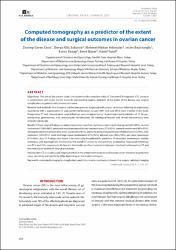| dc.description.abstract | Objectives: The aim of the present study is to determine the predictive value of Computed Tomography (CT), alone or in combination with serum CA-125 levels, for preoperative staging, detection of the extent of the disease, and surgical complications in patients with ovarian carcinoma. Material and methods: One hundred and fourteen patients diagnosed with ovarian carcinoma following an exploratory laparotomy with a preoperative CT scan, performed between January 2007 and June 2013, were enrolled in the study. Preoperative CT and intraoperative surgical findings were compared using 14 parameters and predictions of CT for gastrointestinal, genitourinary, and cardiovascular complications. All radiological features and clinical characteristics were analyzed statistically. Results: CT and surgical findings correlated (sensitivity/specificity) as follows: uterine and tubal spread (66%/89%), cervical involvement (100%/80%), peritoneal nodulesincreased density-carcinomatosis (57%/93%), omental involvement (68%/95%), retroperitoneal involvement (25%/84%), ascites (85%/87%), perirectal and perivesical fat plan obliteration (43%/94%), liver metastasis (50%/91%), small and large bowel involvement (47%/95%), adnexal mass (94%/70%), and other metastases (47%/86%). Also, CT findings were found to be statistically insignificant for prediction of mesenteric involvement, bladder metastasis, and diaphragmatic involvement. The overall CT sensitivity and specificity at detecting intraoperative findings was 91% and 71%, respectively. We found a statistically significant correlation between intestinal involvement on CT and the necessity of additional surgical procedures. Conclusions: CT is a widely used imaging method in the preoperative evaluation of ovarian cancer. However, its predictive value, sensitivity and specificity differ, depending on the anatomical region. | en_US |


















